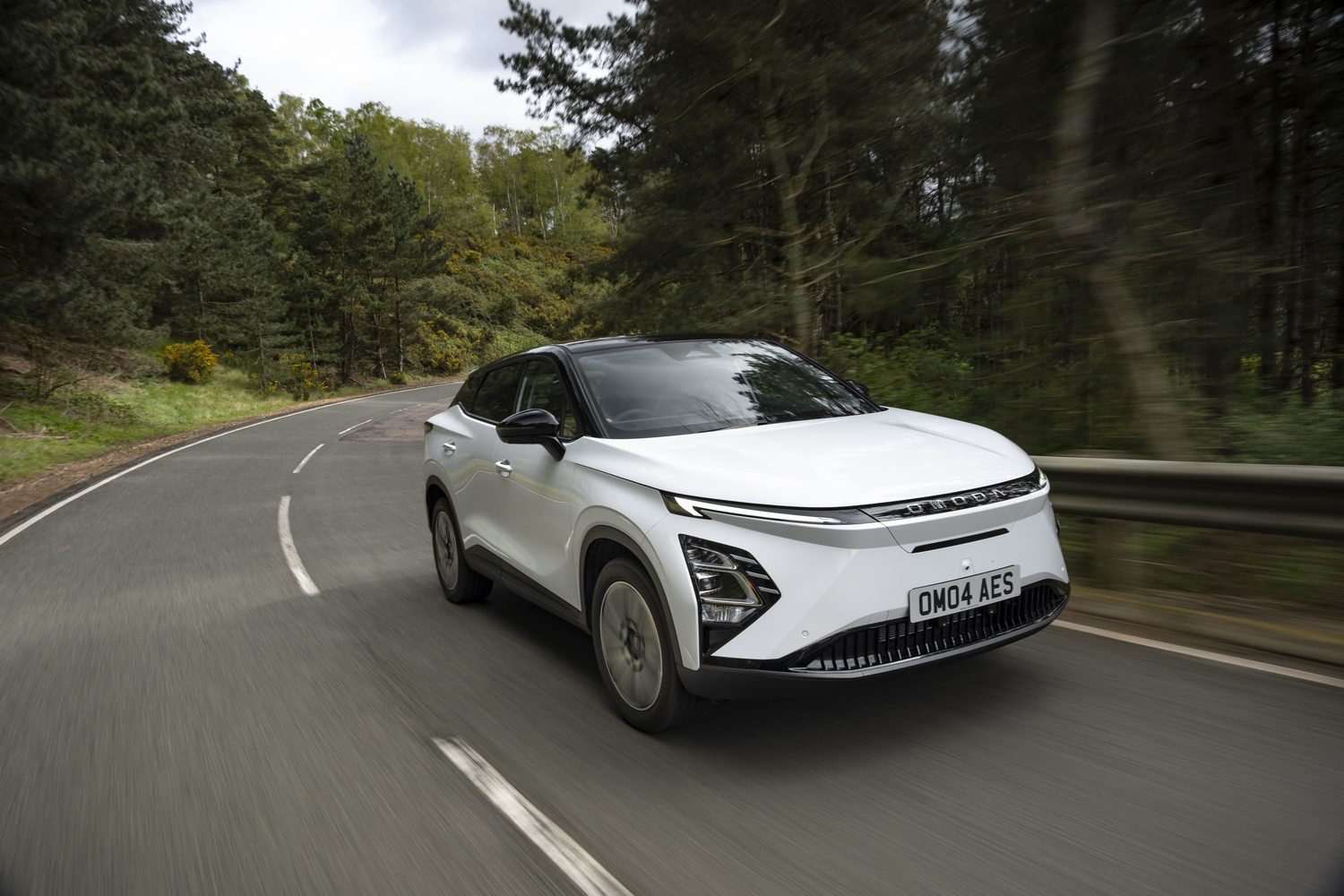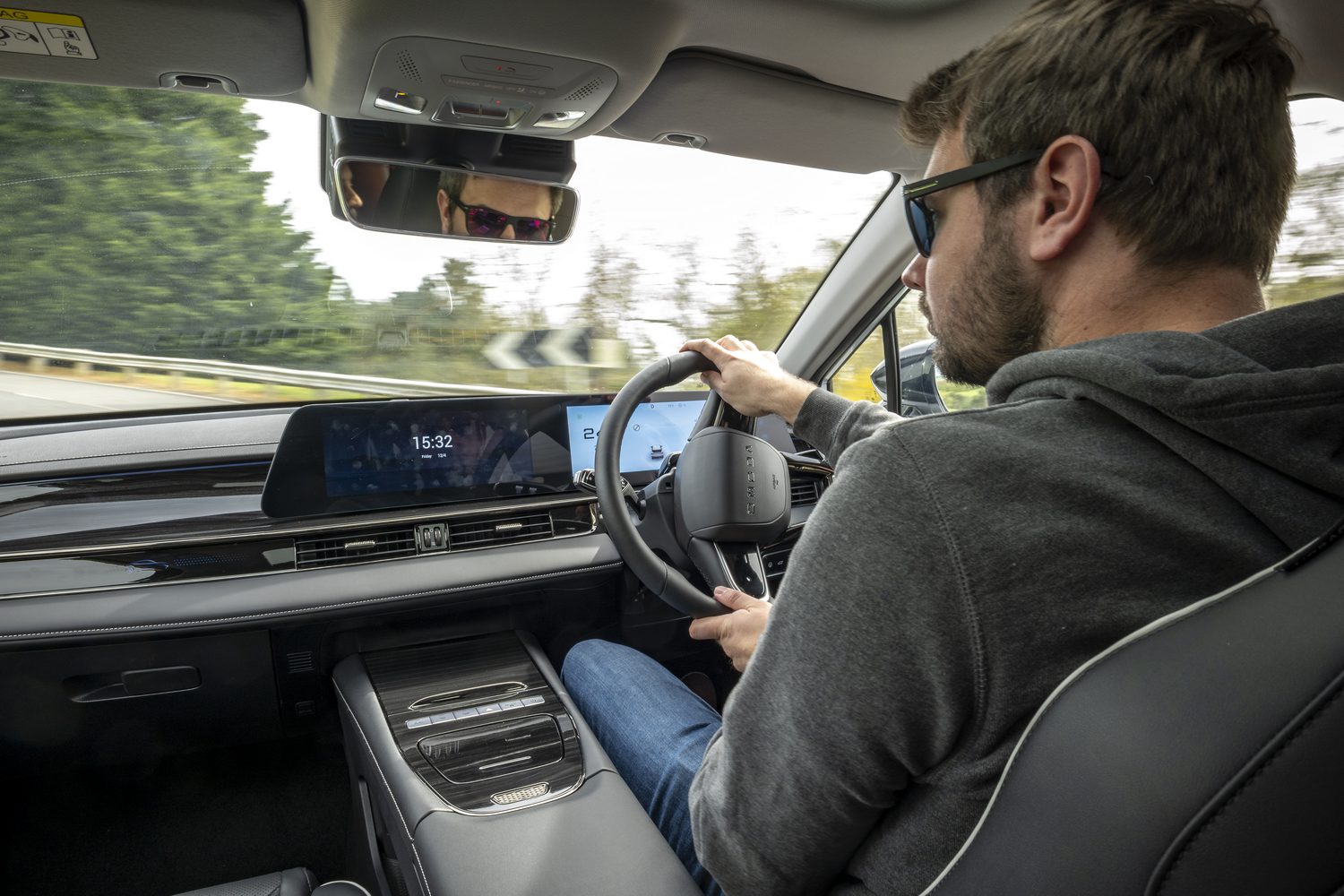Omoda may be unknown in Europe, but this Chinese export brand is part of the enormous Chery business, which is one of China’s biggest car makers and exporters. So, while we may not know much about Omoda, Omoda certainly knows a lot about its European markets. Although it isn’t launching in Ireland just yet, the company is building cars for other European countries including the UK, so we had a quick drive of a prototype vehicle to find out whether the new brand is one to watch.
In the metal

By rights, the Omoda E5 should look like nothing you’ve ever seen before, given its upstart branding and its fresh arrival on the scene. But Omoda is clearly not here to shock its clientele, and the E5 looks fairly reserved, albeit modern. There’s a sharp nose and some intricate light designs, but the overall shape is conventional for a compact SUV that slots in somewhere between the Nissan Qashqai and Juke models in terms of size.
To tell the truth, some of the design features look a little copycat. Does anyone else see some Toyota bZ4X in the nose or some Opel and Nissan cues in the roofline? And the petrol-powered version, known simply as the Omoda 5, is even more of a rip-off thanks to a suspiciously Hyundai Tucson-like grille. Even so, both cars look modern enough, and they blend in seamlessly with every other compact family SUV out there.
Inside, though, Omoda has tried to make the E5 feel a bit more premium than its looks - or its price tag - might suggest. There’s more copycat work in evidence, with some features that have a strong whiff of other manufacturers about them. The Hyundai-like door catches, for example, and the Mercedes-Benz-like window switches. The starter button is identical to that of a Mercedes, too, and even the stitching in the door panels looks reminiscent of that found in cars by a German premium brand from Stuttgart.

But if you’re going to copy anyone, they aren’t the worst options, and for all its lack of imagination in the design, Omoda has built the E5’s cabin well. Everything feels quite robust, and for the price, the materials used are decent. They don’t quite border on the premium, but they’re more mainstream than those you’d find in other budget options. Combine that with quite comfortable seats and a minimalist interior, and you’ve got a perfectly pleasant environment in which to while away a few hours.
Clearly, Omoda has put some emphasis on the tech, which is why you get a pair of screens: one for the infotainment system and the other operating as a digital instrument cluster. The technology used in these systems is pretty sharp - the processor power is more than adequate - so the screens feel nice and responsive, but they aren’t always easy to navigate. Hidden icons and menus and toolbars are secreted away in all sorts of places, and the whole thing feels a little tricky to get your head around. That said, once customers are accustomed to its nuances, it’ll probably prove easy enough, and it’ll likely get a few updates before the car goes on sale.

What’s unlikely to get any serious tweaks before Omoda enters the market is the amount of space available inside. Chinese cars generally favour passenger space over boot space, and the figures certainly suggest that’s the case here. In the E5, the official (albeit provisional) figures say the boot measures just 292 litres when all five seats are upright, which is pitifully small for a car in this class. However, that doesn’t include any storage under the boot floor, and our test car came with a full-size spare wheel, which may not make it into production models.
According to Omoda’s representatives, that 292-litre figure should be taken as a minimum, and the petrol-engined Omoda 5 will be more spacious anyway, because it doesn’t have to hide the electrics for a massive battery. But even then, Omoda says around 380 or so litres of luggage space is to be expected, and that only puts the 5 on a par with a Volkswagen Golf, let alone a T-Roc or a Kia Niro.

Normally, such a cramped boot might be offset by a roomy rear cabin space, but the Omoda’s rear bench isn’t much more than adequate for adults. Legroom is acceptable and headroom is sufficient, which means four adults can sit comfortably, but nobody will pass comment on any especially generous provisions.
Driving it
Under the skin, the Omoda E5 comes with a 60kWh battery under the floor (that’s its usable energy capacity) and a 150kW electric motor driving the front wheels. It’s a simple set-up, and it means you effectively get 204hp heading to the front via a single-ratio automatic transmission that’s controlled by the right-hand stalk on the steering column.
Overall, the powertrain feels pretty useful, but it’s hardly remarkable in terms of efficiency or performance. With a 0-100km/h time of 7.6 seconds, the Omoda feels perfectly brisk enough to keep pace with traffic, but there’s nothing sporty about it.

But nobody is going to choose an Omoda for the sake of performance, even though it handles quite tidily. The suspension has been tuned for Europe, and more improvements may come before the production cars arrive, but the company doesn’t really need to make too many changes to the steering. The car feels smooth and accurate in your hands and while it isn’t especially responsive, that just means it never feels twitchy or nervous.
By the same token, the ride is decidedly mature, albeit a little firm over bumps at low speeds. Omoda itself has admitted some changes to the rear suspension might be in order, but the ride settles down at higher speeds and the E5 is no worse than any other electric SUV in its class when it comes to comfort. In fact, impressive refinement means it’s quite a relaxing car at a cruise, with only a little wind and road noise penetrating the cabin.
When all’s said and done, though, would-be E5 customers will be far more interested in range than how the car drives, and Omoda’s provisional figures suggest reasonable efficiency from the E5, albeit not especially impressive. A 61kWh battery doesn’t sound like the stuff of a long-range champion, but almost all the battery’s capacity - at least 60kWh of it - is available to use, so official range figures are more than reasonable. With a quoted 15.5kWh of energy use every 100km, the battery should be good for just under 400km on a single charge, although that’s only according to the official figures.

Our test wasn’t exactly indicative of real-world use - we were on a closed proving ground and putting the car through its paces in a number of scenarios - but we reckon a range of 300km should be achievable for those who use the car in a more reserved way. With regenerative braking functions and driving modes to help modulate the accelerator response to suit either sporty or economical driving, those living in urban areas might get even more from it.
Either way, Omoda says rapid charging is possible thanks to a charge system capable of accepting up to 80kW. That isn’t spectacular, but the battery is comparatively small and Omoda reckons you can recharge from 30 to 80 per cent in less than half an hour. We’ll gloss over the fact most European electric cars can get from 10 or 20 per cent to 80 per cent in that kind of time, shall we? In fairness, though, most owners will charge at home and overnight charging shouldn’t be a problem with that 60kWh capacity.
If all this talk of charging doesn’t sound much like your cup of tea, you can also go for a petrol-powered Omoda, in the shape of the conventional (and very cheap) 5. With a 1.6-litre turbocharged petrol engine producing 186hp, it’s almost as fast as the E5, and it’ll go further between fills. The seven-speed automatic gearbox feels a bit jagged at low speeds, but otherwise it’s all quite smooth and refined, if not as quiet as the E5.

Like the E5, though, the 5’s range isn’t what it could be, thanks in part to a slightly low official economy figure. Admittedly, it may change in time, but burning through eight litres of unleaded every 100km seems a bit much to us. Nevertheless, it’ll be there if customers want it, and it’ll be cheap. It’ll also be joined later by hybrid options that may make more sense to many buyers.
What you get for your money
Omoda says it has no plans to launch in Ireland for the time being, but that it expects to enter the market if other European ventures go to plan. That said, the company will bring the 5 and E5 to the UK later this year and importing one (Omoda has no dealers in Northern Ireland) should be reasonably inexpensive given the low VRT - not that Revenue will know what to do with it. Obviously, you’ll have to spend a little more on the more upmarket Noble trim, but we’re still talking about a car that undercuts its rivals significantly. It’s expected to offer a competitive amount of equipment, too, although details are yet to be finalised.
Summary

The Omoda E5 is not perfect, and although it’s likeable enough, it can’t beat its rivals from Europe, South Korea and Japan. That said, it will be cheaper than its rivals, and you can forgive a lot when the price difference is noticeable. Even so, we can’t quite bring ourselves to recommend the E5 - at least not on the showing of this prototype - but it has intrigued us enough to ensure we’ll be watching Omoda’s progress with interest. This is a solid first attempt.


























